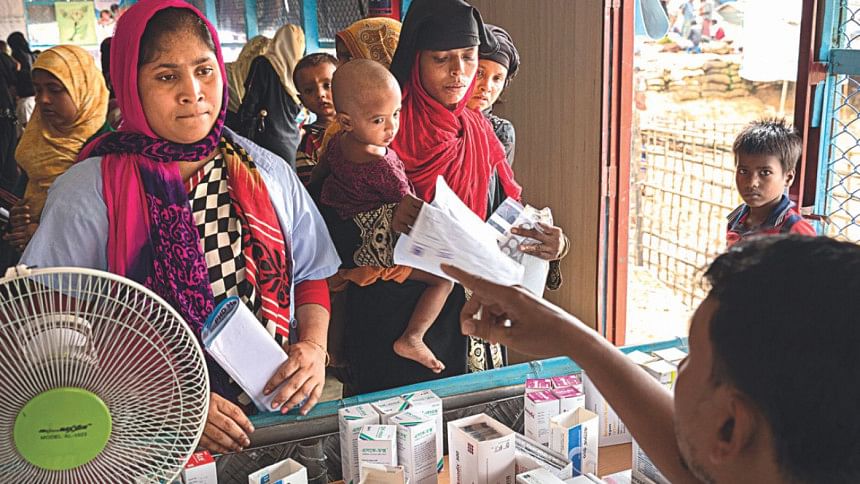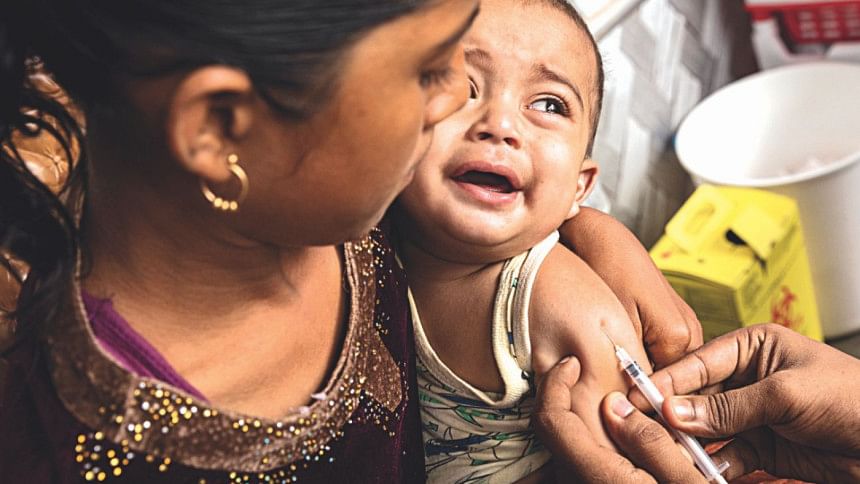Extending the benefits of primary health care Across both communities

Health post, Camp 4, Kutupalong camp: There's an unmistakable hint of pride in Dr Kazi Islam's manner as he shows visitors around the bustling primary health care centre where he works as medical officer in charge. At first sight, the location – next to a busy unpaved road through Kutupalong's Camp 4 – is unremarkable.
But as Dr Kazi quickly points out, the health post – operated by the NGO Partners in Health and Development with UNICEF support – only moved here recently because of the danger of landslides at its former site. Moreover, the neat, blue-painted building is constructed of brick and cement, and far more durable than the bamboo structure it replaced.
Inside, around 30 women, many with small children, sit in the waiting area. Twenty-year-old Olmorija has come with her three-month-old baby Abu Salam, who is suffering from a fever and cough.
“I heard about this place through the health volunteer who came to my shelter,” Olmorija says, referring to one of eight volunteer counselors based at the centre who go door-to-door in the surrounding camp to promote its services.
Olmorija adds that when Abu Salam recovers, she will bring him back to receive his various immunisations. This is significant since the benefits of vaccines were almost entirely unknown to Rohingya communities back in Myanmar. Convincing newly- arrived refugees to protect their children in this way has not always been easy, due to various rumours spread about their supposed harmful side-effects (see page 24).
Vaccinations for young children (including the BCG vaccine to prevent tuberculosis and vaccines for measles, rubella and polio) are dispensed three times a week at the centre. Tetanus-diphtheria (Td) vaccine for pregnant women is also available. A range of other routine services are on offer for children under five as well as ante-natal and post-natal care for mothers and babies.

“Each day here is different,” says Dr Kazi. “But the most frequent ailments we treat are diarrhoea, and common cold.”
This particular morning, he has already given advice or treatment to a man with tuberculosis (who he referred to a nearby clinic), the mother of a baby who may be autistic, and a small girl who had been hurt in one of the traffic accidents that are a frequent occurrence on the camp's chaotic trails.
Health posts like Dr Kazi's – along with six larger primary health centres and five diarrhoea treatment centres – have been key to avoiding major public health crises in the months since the refugees' arrival last August.
A series of successful immunisation campaigns – nine in all in the space of ten months have also played a critical part in averting the worst fears of health officials.
“Given the physical condition the arriving refugees were in, and the lack of vaccination coverage they had, we expected worse outbreaks than have occurred so far,” says UNICEF Health Specialist Yulia Widiati.
Not that there is room for complacency. Outbreaks of measles, and diphtheria were alarming enough. And while successive campaigns achieved impressive coverage rates, mobilising the refugees for follow-up vaccination rounds has proved difficult.
Among the major tasks going forward will be shifting away from expensive vaccination campaigns in favour of a routine immunization system that will benefit refugees and host population alike.
“We have a longstanding partnership with local health authorities, and we need to strengthen that further going forward, so that refugees and host community children alike see the benefit of the improved maternal, newborn, child and adolescent health services that are being put in place,” says Widiati.

 For all latest news, follow The Daily Star's Google News channel.
For all latest news, follow The Daily Star's Google News channel. 



Comments